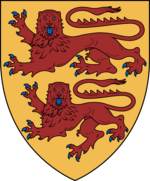House of Astulf
This article is incomplete because it is pending further input from participants, or it is a work-in-progress by one author. Please comment on this article's talk page to share your input, comments and questions. Note: To contribute to this article, you may need to seek help from the author(s) of this page. |
| Astulf Astulfing, Astulfid | |
|---|---|
| Noble House | |
 Arms of the House of Astulf; Or, two lions passant guardant in pale gules armed and langued azure. | |
| Country | Herastadt |
| Founded | 10th century |
| Founder | Konrad I, Count of Petra |
| Titles | |
| Dissolution | 1508 |
| Cadet branches |
|
The House of Astulf, (Heran: Ҁτςгⲇινι) commonly known as the Astulfings or Astulfids was a Heran noble house founded in the 10th century. The name of the house is derived from Astulf I, Count of Petra, the dynasty's progenitor. the Astulfings are most notably known for being the founding dynasty of the Principality of Herastadt.
Founded in the 10th century by Konrad the Bastard, illegitimate son and successor to the Count of Petra, the family rose to prominence in 1186 with the inheritance of the Duchy of Pirakon from Sigmund II of House Tellingen. After two centuries of rule, the Astulfings under Kostav I of Pirakon united the Parazin Isles at the head of the Confederation of Saint Hera in 1395, ruling the united isles as self-proclaimed Prince-Stewards. Kostav's successors went on to cement Herastadt's geopolitical position in the region; soon rising to become the dominant maritime and merchant power of the Parazin Sea. Toward the late 15th century, growing divisions within the dynasty boiled to the surface with the death of Kostav III; leading to the Herastadtian Succession War and the deposition of his successor Mathias I by Tasso I of Corgau.
The legacy of the House of Astulf has been profound in Herastadt; being the driving force behind unification, and the architects of early Herastadtian legal code and state function through foundation of the Council of Banners and Chamber of Seneschals. Though extinct in the main line, the House was survived through its cadet branches; the most prominent of which being the reigning House of Lindonis.
Ancestry
Dardenic Invasions
With the collapse of the Parazin Confederation in 476, the Parazin Isles were left fragmented for the first time in over four centuries. In the chaos the disparate tribes and peoples once held together in common defence devolved into various rivaling successor states; all struggling to establish dominance over the Isles and declare themselves the heirs to Queen Hera's legacy. Nearly a century of conflict ensued, and by the year 560 the Isles were left decimated and weak, vulnerable to the coming Dardenic Invasion.
Beginning with the overthrow of the Verni Kingdom by opportunistic Dardenic mercenaries, the Parazin Isles were swept by a sudden wave of Dardenic migration. Originally consisting of bands of auxiliaries and their families; this was soon compounded in 563-78 with the conquest of Old Batania by the expanding Baatenian Empire, leading to the arrival of tens of thousands of Dardenic peoples along the northern coasts. Over the following century and a half, these foreign peoples slowly subjugated the Isles, valley by valley, until they reached the southern shores of the Parazin Channel.
Once the conquest of the Isles were complete, the local peoples found themselves systematically torn from positions of power, and replaced by northern Warlords and Chiefs from the northern mainland. Settling in, the largely Batani landowners lorded over the native population, in time coming to formally establish kin-groups such as the Antharingi and Grodengi. By the mid 9th century, these kin-groups began to mold into more distinctive Noble Houses, the Batani nobility enthusiastically emulating the ways of their more civilized Baatenian cousins.
House of Vesteholm
One of the earliest known Houses is that of Vesteholm, founded by a minor nobleman given control of the town of Petra and surrounding lands (known as Vesteholm to the Dardenic elite) by the Duke of Pirakon in the late 7th century. At this time it is believed that these lands were the site of frequent attacks by seaborne Uscanian raiders, however few records exist to verify the archaeological evidence. It is not until the year 781 that documentation is able to confirm House Vesteholm's rule over Petra, listing 'Count Sinibald' as the ruling lord of that title in the Grand Tithing conducted during the rule of Duke Sigmund I of Pirakon.
Though literary records gradually became more common in the Parazin Isles from this point, tracking the lineage of House Vesteholm has proven difficult for historians due to existing records being largely ecclesiastical texts and records of the Early Doxologic Temple. One of the few concrete truths of this era is the birth of Konrad the Bastard as son to Count Astulf of Petra. This is known through surviving Temple documents in which Konrad was granted noble accolade at the behest of Astulf in the year 916. It is understood that this was a common practice for lords in this period who had no trueborn issue, as the concept of legitimization was frowned upon as being distruthful.
Foundation
Konrad the Bastard
By being granted noble accolade by his father, Konrad was granted a new House of his naming. In this he chose his father's name as the name of his house, which was a common practice of the time. No further record of Konrad exists until the year 922, when he inherited the County of Petra upon the death of Astulf.